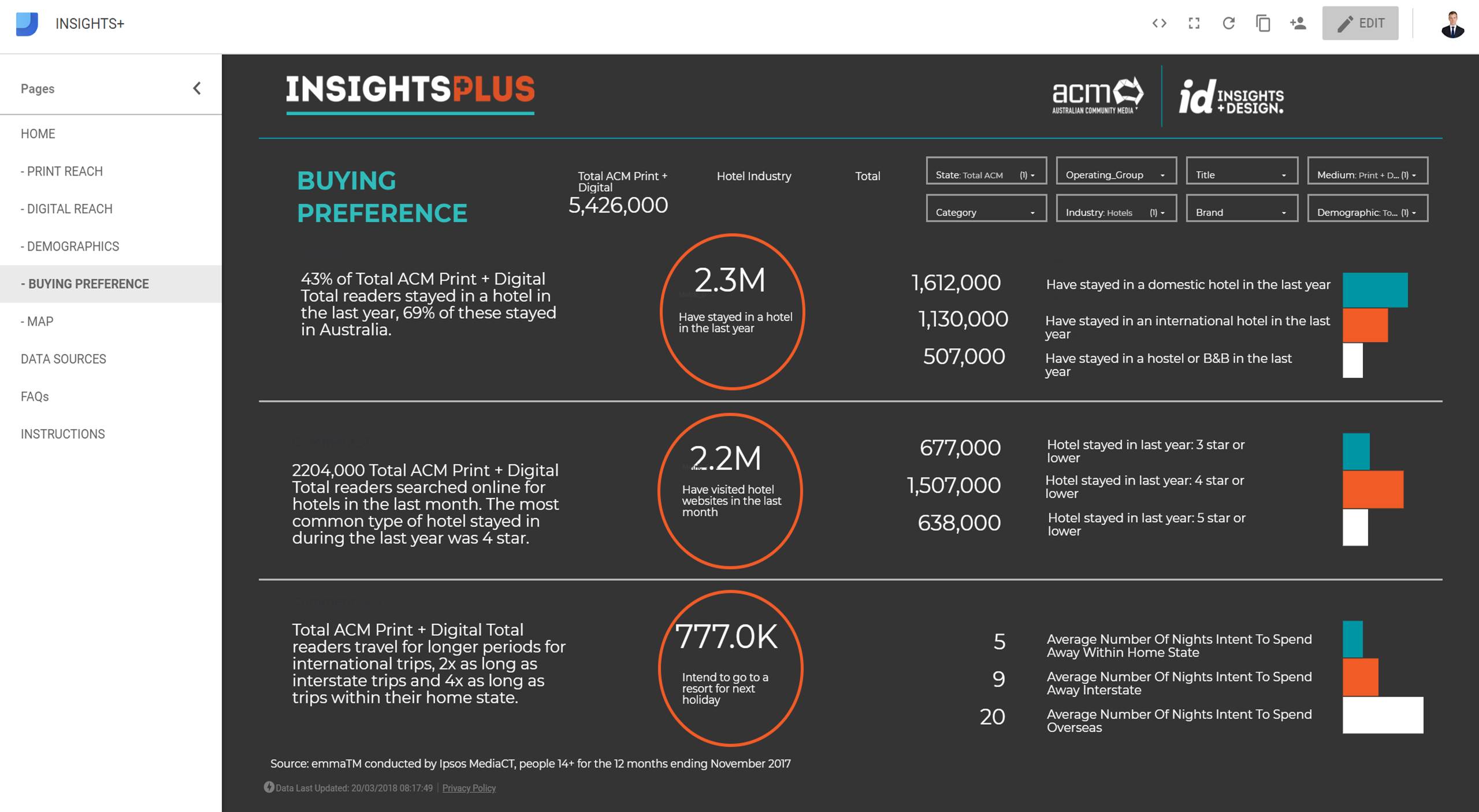Fairfax Media’s BIGGIES Award-winning, data-driven revenue tool

Robert Tidball
Research and Business Analyst
Fairfax Media, Australia

Australian Community Media (ACM) is the regional news and content publishing division of Fairfax Media. It has a network of over 600 sales people, admin and managers who require up to date audience information for each of the 200 news brands they own and additional 100 they represent. Each news brand can have thousands of individual clients each year. Sales offices are distributed over every state in Australia without a centralised distributor of sales collateral.
Providing sales collateral based on research has historically been a difficult task. Audience metrics for print are provided by Ipsos (through emmatm), digital metrics by Nielsen or Google Analytics and demographic metrics by census data (ABS). Because of the number of different data sources; provision of research was previously conducted by one analyst who provided ad hoc research to sales reps servicing the largest clients, the remaining sales reps did not receive data-driven sales collateral.
It quickly became apparent that rather than creating ad hoc reports for hundreds of sales reps it would be more efficient to create a self-service business intelligence platform that contained audience research data. The platform can then be used as a single source of truth for audience data by the entire business unit. Each page on the BI platform contained data from a different source, available data includes: print and digital reach, demographics, web analytics, audience buying preference and maps of distribution areas. On each page users are able to select which title they are representing and their desired metrics.
This project was completed by one analyst over the course of a year with no additional cost to the business, all tools and data used were either free or already in use within the business. Given that this was a solo project the planning process was extremely agile. Significant milestones included pitching a MVP to management in February 2017, soft launching in September 2017 and hard launching in February 2018. The data inputs for the platform are 3rd party sources meaning that they don’t integrate directly so the entire ETL process has to be completed manually. Data is exported into csv, transformed in excel then loaded into Google Cloud Storage, Big Query then Data Studio. With the exception of exporting 3rd party data into excel the entire process uses Google products in order to utilise the big data capabilities of Big Query and data visualisation of Data Studio. These tools also had the benefit of being free and integrating with the business due to the use of G-Suite and Google Chrome by members of the business.
Sales reps can view audience buying preferences for over 50 different industries and 350 Australian brands, this data is available for 200 newspapers and websites or combinations of both. This results in over 200,000 different combinations of brands/industries and newspapers and news sites. Each page is designed to be a stand-alone sales argument and the data is accompanied by Natural Language Generation insights which aid the salesperson in explaining the research to the client. This NLG functionality was built in during the ETL process before being loaded into Big Query.

The platform was soft launched in September 2017 to a select group of sales managers within the organisation. These early adopters were used to gather feedback before launching in February 2018 at an internal conference. Early feedback was instrumental in improving user experience and also highlighted the need to educate users on how to effectively use insights to sell. Users were educated through a combination of small group demonstrations, a conference presentation to 100 stakeholders and live-streaming a video demonstration to hundreds of stakeholders. Early learnings during this feedback period demonstrated that salespeople were copying data from the platform and pasting it into their existing sales decks. The next phase of the project will be to create an end-to-end solution using the same design principles in which salespeople are provided with a finished sales deck.
The platform is online and can be accessed through a link. Users reach this link through the company’s internal social media platform (Facebook Workplace), uptake of the platform was viral as early adopters of the platform then shared the link with an average of 5 co-workers. Data security is managed through Google, because Data Studio is a Google product all new users have to individually request access from the document owner. This allows the owner to prevent the platform being shared outside of the company and also track individual usage.
User activity is measured through Google Analytics, during beta stage there were 50 monthly users, on launch this increased to 80 users on day one and 350 monthly users following adoption. Originally it was assumed that salespeople would use their iPads to access the program and the dashboards were optimised for iPad, this assumption turned out to be incorrect as 97% of usage is through desktop computers. This insight aided in optimising the product for an easier user experience. User behaviour within the platform is also tracked by analysing queries to the underlying Big Query database. This allows analysis of metrics and newspapers selected by sales reps when pitching to clients, this informs product management decisions as popular industries such as real estate can be expanded on.
Feedback from salespeople indicates that insights from the platform have contributed directly to generating new revenue. Additionally, sales people now have more time to sell rather than search for information to put into pitching decks so the platform has saved a significant amount of time for salespeople and marketing managers. Prior to the launch of the platform; audience insights were transmitted in static documents via email, this was time consuming and resulted in out-of-date information being used throughout the business. The business has benefitted from the existence of a single source of truth as the data is always accurate and always up to date. The platform is now seeing adoption in business units outside of sales as its insights have been quoted by journalists in ACM publications. The platform has also gained success on the international awards circuit as it came first in the BIGGIES Global – Excellence in Business Process Efficiency category and is currently a finalist in INMA Awards categories for Audience Research and Data Analytics.
The project is sustainable long-term as the data processing runs on Google Cloud meaning that it is scalable to our needs and costs to expand functionality will be variable. The current project is unifying all disparate sources of data into a data warehouse which would be accessible to users via InsightsPlus. A key learning of this project has been that all data sources need to be transferred into the cloud using APIs as quickly as possible and there are significant benefits to maintaining all data flows and storage on the same IaaS platform (in this case Google Cloud Platform).
